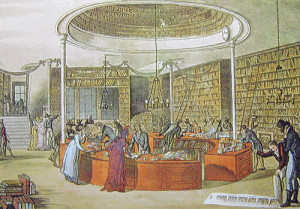With Napoleon rampaging around Europe, the grand tour was a little more problematic during our period. But country house visiting was quite the thing.
This wasn’t always to the taste of estate owners. In 1783, Horace Walpole wrote to Sir Thomas Mann
“I am tormented all day and every day by people that come to see my house, and have no enjoyment of it in summer. It would be even in vain to say that the plague was here. I remember such a report in London when I was a child ,and my uncle Lord Townshend, then secretary of state, was forced to send guards to keep off the crowd from the house in which the plague was said to be–they would go and see the plague. had I been master of the house, I should have said… “You see the plague! you are the plague.”
Poor Horace was so inundated with visitors to his extraordinary house-Strawberry hill, Richmond, that after he had been disturbed at dinner by the arrival of three Germans Barons who wished to visit his house, he eventually would only allow his housekeeper to admit people to his house if they could show her a signed ticket obtained from him in advance. Such was the demand for these visits that Walpole had tickets printed– he still signed them and inserted the date of the proposed visit — and went so far as to print “a page of rules for admission to see my House”:
“…..Mr Walpole is very ready to oblige any curious persons with the sight of his house and his collection…it is but reasonable that such persons as send, should comply with the rules he has been obliged to lay down for showing it.
No ticket will serve but on the day for which it is given.If more than four persons come with a ticket,the housekeeper has positive order to admit none of them….
Every ticket will admit the company only between the hours of twelve and three before dinner,and only one company will be admitted on the same day.
They that have tickets are desired not to bring children…”
Chatsworth was the first house to adopt the habit of reserving “open days” for tourists and as early as 1760 it was open only on two public days each week.
Derbyshire was a very popular destination — with the Peak district, Matlock, spas at Buxton, and houses such as Chatsworth, Haddon Hall and Kedelston.

Mrs. Garnett – Kedleston Hall
Mrs Garnett, who was the housekeeper at Kedelston, was famous for her guided tour. In her hand you can see a copy of Catalogue of Pictures, Statues, &c. at Kedleston, ready to put it into the hand of the next enquiring visitor. Such guidebooks had been produced at Kedleston since 1769, with subsequent editions revised to take account of the expanding art collection. It was an important means of recording the identities of the sitters in portraits, which were of greater interest to 18th-century visitors than matters of attribution or iconography. A consequence of not having such aids was recorded by Horace Walpole, who described how at Petworth the 6th Duke of Somerset refused to let his servants have new picture lists, “so that when he died, half the portraits were unknown by the family.”
Although it was by no means uncommon for house servants to act as guides, it was unusual for the housekeeper herself to be painted. That she was immortalized in this way perhaps indicates the respect and affection in which this long-serving and highly capable servant was held; indeed, she was given a gravestone describing her as “sincerely regretted.”
In 1777 she took Samuel Johnson and James Boswell around the house: “Our names were sent up, and a well-drest elderly housekeeper, a most distinct articulator, shewed us the house… We saw a good many fine pictures… There is a printed catalogue of them which the housekeeper put into my hand; I should like to view them at leisure.”
An excellent book on Country House visiting is Adrian Tinniswood’s The Polite Tourist.
 Yesterday, the neighborhood cat came to our patio door to taunt and torture our cats and I did a foolish thing. I reached down to stop our “Devil Cat” from rushing the screen and he bit me! Good. His canine tooth sank into the skin of my palm right below my thumb. A couple of other teeth did less damage. I washed and soaked and slathered the wounds with antibiotic cream and bandaged them. Today I’ll call my doctor’s office. My hand hurts and I’m running a low grade fever but other than that, I’m not worried. My cat is current on his rabies shots and, being an indoor cat, he is never exposed to rabid animals anyway. And even if my cat had rabies, at least there is a (reputedly unpleasant) cure.
Yesterday, the neighborhood cat came to our patio door to taunt and torture our cats and I did a foolish thing. I reached down to stop our “Devil Cat” from rushing the screen and he bit me! Good. His canine tooth sank into the skin of my palm right below my thumb. A couple of other teeth did less damage. I washed and soaked and slathered the wounds with antibiotic cream and bandaged them. Today I’ll call my doctor’s office. My hand hurts and I’m running a low grade fever but other than that, I’m not worried. My cat is current on his rabies shots and, being an indoor cat, he is never exposed to rabid animals anyway. And even if my cat had rabies, at least there is a (reputedly unpleasant) cure. In the mid 1700s, a serious outbreak of rabies swept London. All dogs were ordered confined for one month and a reward of 2 shillings for killing dogs on the streets led to a carnage.
In the mid 1700s, a serious outbreak of rabies swept London. All dogs were ordered confined for one month and a reward of 2 shillings for killing dogs on the streets led to a carnage.






